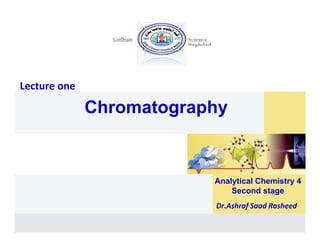
Lecture 1 analytical chemistry 4-second stage
- 1. Lecture one ChromatographyChromatography Analytical Chemistry 4 Second stage Dr.Ashraf Saad Rasheed
- 2. Introduction to chromatography •Chromatography is a variety of physicochemical techniques for the separation of components withintechniques for the separation of components within mixtures; all methods are based on the distribution of a component between two immiscible phases, the stationary phase and mobile phase. •The chromatographic methods are divided according to theg p g physical state of these phases. •The invention of chromatography is drawback to Russian•The invention of chromatography is drawback to Russian Botanist "Mikhail Tswett" who has introduced column chromatography in 1906. Dr.Ashraf Saad Rasheed2
- 3. • Mikhail Tswett employed the technique to separate various plant pigments such as chlorophylls and xanthophylls byplant pigments, such as chlorophylls and xanthophylls, by passing solutions of these species through glass columns packed with finely divided calcium carbonate. • The separated species appeared as colored bands on the column which accounts for the name he chose for thecolumn, which accounts for the name he chose for the method. • The term of chromatography is derived from Greek chroma meaning "color" and graphein meaning to "writing". 3 Dr.Ashraf Saad Rasheed
- 4. • The distributions of the component to be separated between phases are Either • by solubility difference of solute in both phases – this called a partition chromatographycalled a partition chromatography. •or • by adsorption difference of solute in the stationary phase– this called adsorption chromatography. 4 Dr.Ashraf Saad Rasheed
- 5. Classification of Chromatographic Methods • There are several types of classifications for the chromatographic methods; we can mention part of them as flows:flows: 1. depending on the physical nature of two phases(depe d g o e p ys ca atu e o o p ases( stationary and mobile) and consequently they classified by first referring to name of mobile phase; – Mobile stationary phase phase Gas Solid Liquid 5 Dr.Ashraf Saad Rasheed phase phaseLiquid Solid
- 6. 2. Chromatography is subdivided into categories on the basis of mechanism of interaction of the solute withbasis of mechanism of interaction of the solute with the stationary phase, as follows a. Adsorption Chromatography: a solid stationary phase and a liquid or gas mobile phase are used. Solute is adsorbed on the surface of the solid particles .the more strongly a solute is adsorbed, the slower it travels through the column. A typical example of this type is the Thin layerexample of this type is the Thin-layer Chromatography (TLC) in which the stationary phase is solid supported on a glass plate (Planer Ch )Chrom.) 6 Dr.Ashraf Saad Rasheed
- 7. b. Partition Chromatography: a high-boiling liquid stationary phase is bonded to a solid surface, whichy p , is typically the inside of the silica (SiO2) chromatography column in gas chromatography, solute equilibrate between the stationary liquid andsolute equilibrate between the stationary liquid and the mobile phase, which is the flowing gas in GC. c. Ion-exchange Chromatography: Anion such as – SO3 - or cation such as –N(CH3)3 + are covalently attached to the stationary solid phase usually a resinattached to the stationary solid phase, usually a resin, in this type of chromatography. Solute ions of the opposite charge are attracted to the stationary phase b l t t ti f Th bil h i li idby electrostatic force. The mobile phase is a liquid. 7 Dr.Ashraf Saad Rasheed
- 8. d. Molecular Exclusion Chromatography: also called gel filtration or gel permeation chromatography Thisfiltration or gel permeation chromatography. This technique separates molecules by size , with the larger solutes passing through most quickly 8 Dr.Ashraf Saad Rasheed